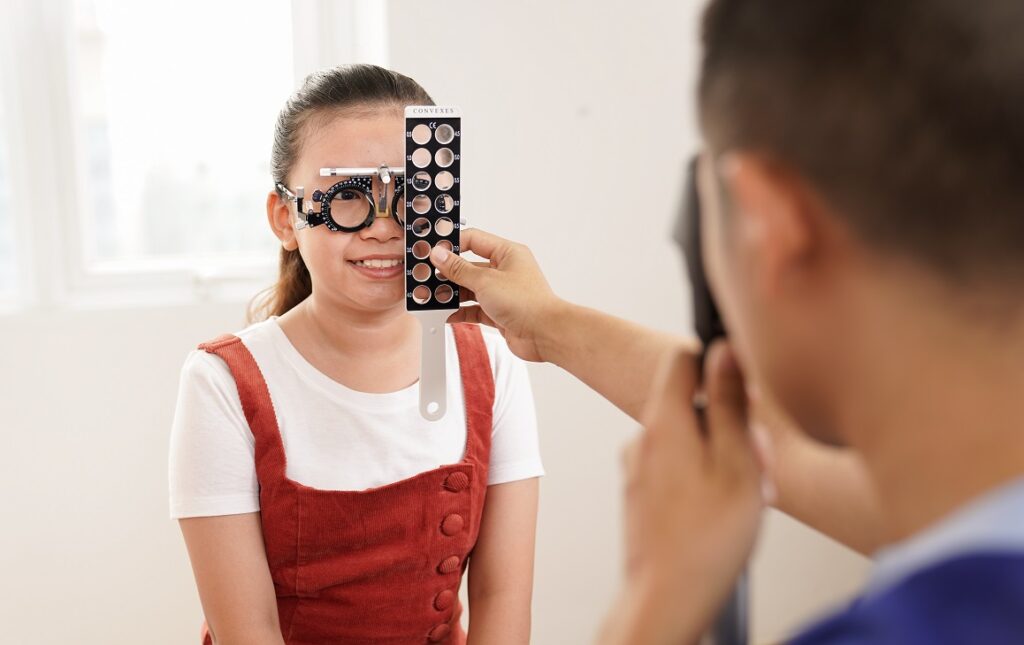
Prima Medical Center Saigon, Refractive and Lasik
Why myopia progression is a concern
27 July, 2024
Prima Saigon Eye Hospital: Are your child’s eyes getting worse year after year? Some children who develop myopia (nearsightedness) have a continual progression of their myopia throughout the school years, including high school.

Prima Saigon Eye Hospital: Some children who develop myopia (nearsightedness) have a continual progression of their myopia throughout the school years, including high school.
And while the cost of annual eye exams and new glasses every year can be a financial strain for some families, the long-term risks associated with myopia progression can be even greater.
More children are becoming nearsighted
Myopia is one of the most common eye disorders in the world. The prevalence of myopia is about 30 to 40 percent among adults in Europe and the United States, and up to 80 percent or higher in several East Asian countries.
And it’s estimated that by the year 2050, roughly half of the world’s population will be nearsighted.
Classification of myopia severity
Myopia — like all refractive errors — is measured in optical units called diopters (D). Lens powers that correct myopia are preceded by a minus sign (–), and are usually measured in 0.25 D increments.
The severity of nearsightedness is often categorized like this:
- Mild myopia: -0.25 to -3.00 D
- Moderate myopia: -3.25 to -5.00 D or -6.00 D
- High myopia: greater than -5.00 D or -6.00 D
Mild myopia typically does not increase a person’s risk for eye health problems. But moderate and high myopia sometimes are associated with serious,
When myopia-related eye problems and vision loss occur, high myopia also is called degenerative myopia or pathological myopia.
Adults with high myopia usually started getting nearsighted when they were young children, and their myopia progressed year after year.
Myopia-related eye problems
Significant eye problems that can be associated with nearsightedness include:
Cataracts:
In a recent study of cataracts and cataract surgery outcomes among Koreans with high myopia, researchers found cataracts developed sooner in highly myopic eyes compared with normal eyes. Also, eyes with high myopia had a higher prevalence of coexisting disease and complications, such as retinal detachment.
And in an Australian study of more than 3,600 adults ages 49 to 97, the odds of having cataracts increased significantly with greater amounts of myopia. The odds of having a particular type of cataract was twice as high among subjects with high myopia compared with those with low myopia.
Glaucoma:
Myopia — even mild and moderate myopia — has been associated with an increased risk of glaucoma. In the same Australian study mentioned above, glaucoma was found in 4.2 percent of eyes with mild myopia and 4.4 percent of eyes with moderate-to-high myopia, compared with 1.5 percent of eyes without myopia.
The study authors concluded there is a strong relationship between myopia and glaucoma , and that nearsighted participants in the study had a two to three times greater risk of glaucoma than participants with no myopia.
Also, in a Chinese study , glaucoma was significantly associated with the severity of myopia. Among adults age 40 or older, those with high myopia had more than twice the odds of having glaucoma as study participants with moderate myopia, and more than three times the odds of having the disease compared with individuals with mild myopia.
Compared with participants who either had no myopia or were farsighted, those with high myopia had a 4.2 to 7.6 times greater odds of having glaucoma.
Retinal detachment:
In a study published in American Journal of Epidemiology, researchers found myopia was a clear risk factor for retinal detachment.
Results showed eyes with mild myopia had a four-fold increased risk of retinal detachment compared with non-myopic eyes. Among eyes with moderate and high myopia, the risk increased 10-fold. The study authors also concluded that almost 55 percent of retinal detachments not caused by trauma are attributable to myopia .
In the Korean study mentioned above, among participants with high myopia due to elongated eye shape (axial myopia), the incidence of retinal detachment after cataract surgery was 1.72 percent, compared with 0.28 percent among participants with normal eye shape.
In a study conducted in the UK that evaluated the incidence of retinal detachment after cataract surgery, 2.4 percent of highly myopic eyes developed a detached retina within seven years following cataract extraction, compared with an incidence of 0.5 to 1 percent among eyes of any refractive error that underwent cataract surgery.
What you can do about myopia progression
The best thing you can do to help slow the progression of your child’s myopia is to schedule annual eye exams so your eye doctor can monitor how much and how fast his or her eyes are changing.

Prima Saigon Eye Hospital: Consult with doctor to slow child’s myopia progression.
Often, children with myopia don’t complain about their vision, so be sure to schedule annual exams even if they say their vision seems fine.

Prima Saigon Eye Hospital: Are your child’s eyes getting worse year after year?
If your child’s eyes are changing rapidly or regularly, ask our eye doctor @ Prima Saigon Eye Hospital about ortho-k contact lenses or other myopia control measures to slow the progression of nearsightedness.
Schedule annual eye exams
If your child is nearsighted, schedule annual eye exams with an eye doctor @ Prima Saigon Eye Hospital. During the exam, ask about available myopia control measures to slow the progression of your child’s nearsightedness.
Dr QUYNH Ha, Senior Consultant (Refractive & Lasik)
If you need an eye assessment, please have a visit to Prima Saigon Eye Hospital
- Address: 27 Ky Dong St, District 3, HCMC
- Website: https://primahealth.vn/en/
- Business Hours: 07:30 – 17:00 from Monday – Saturday
- HOTLINE: 0919-209-039 or 1900 – 9115
Prima Saigon Eye Hospital recommends that clients should reserve their intended consultation at least three days before their visit for convenience and less waiting time.
Prima Saigon Eye Hospital: Are your child’s eyes getting worse year after year? Some children who develop myopia (nearsightedness) have a continual progression of their myopia throughout the school years, including high school.

Prima Saigon Eye Hospital: Some children who develop myopia (nearsightedness) have a continual progression of their myopia throughout the school years, including high school.
And while the cost of annual eye exams and new glasses every year can be a financial strain for some families, the long-term risks associated with myopia progression can be even greater.
More children are becoming nearsighted
Myopia is one of the most common eye disorders in the world. The prevalence of myopia is about 30 to 40 percent among adults in Europe and the United States, and up to 80 percent or higher in several East Asian countries.
And it’s estimated that by the year 2050, roughly half of the world’s population will be nearsighted.
Classification of myopia severity
Myopia — like all refractive errors — is measured in optical units called diopters (D). Lens powers that correct myopia are preceded by a minus sign (–), and are usually measured in 0.25 D increments.
The severity of nearsightedness is often categorized like this:
- Mild myopia: -0.25 to -3.00 D
- Moderate myopia: -3.25 to -5.00 D or -6.00 D
- High myopia: greater than -5.00 D or -6.00 D
Mild myopia typically does not increase a person’s risk for eye health problems. But moderate and high myopia sometimes are associated with serious,
When myopia-related eye problems and vision loss occur, high myopia also is called degenerative myopia or pathological myopia.
Adults with high myopia usually started getting nearsighted when they were young children, and their myopia progressed year after year.
Myopia-related eye problems
Significant eye problems that can be associated with nearsightedness include:
Cataracts:
In a recent study of cataracts and cataract surgery outcomes among Koreans with high myopia, researchers found cataracts developed sooner in highly myopic eyes compared with normal eyes. Also, eyes with high myopia had a higher prevalence of coexisting disease and complications, such as retinal detachment.
And in an Australian study of more than 3,600 adults ages 49 to 97, the odds of having cataracts increased significantly with greater amounts of myopia. The odds of having a particular type of cataract was twice as high among subjects with high myopia compared with those with low myopia.
Glaucoma:
Myopia — even mild and moderate myopia — has been associated with an increased risk of glaucoma. In the same Australian study mentioned above, glaucoma was found in 4.2 percent of eyes with mild myopia and 4.4 percent of eyes with moderate-to-high myopia, compared with 1.5 percent of eyes without myopia.
The study authors concluded there is a strong relationship between myopia and glaucoma , and that nearsighted participants in the study had a two to three times greater risk of glaucoma than participants with no myopia.
Also, in a Chinese study , glaucoma was significantly associated with the severity of myopia. Among adults age 40 or older, those with high myopia had more than twice the odds of having glaucoma as study participants with moderate myopia, and more than three times the odds of having the disease compared with individuals with mild myopia.
Compared with participants who either had no myopia or were farsighted, those with high myopia had a 4.2 to 7.6 times greater odds of having glaucoma.
Retinal detachment:
In a study published in American Journal of Epidemiology, researchers found myopia was a clear risk factor for retinal detachment.
Results showed eyes with mild myopia had a four-fold increased risk of retinal detachment compared with non-myopic eyes. Among eyes with moderate and high myopia, the risk increased 10-fold. The study authors also concluded that almost 55 percent of retinal detachments not caused by trauma are attributable to myopia .
In the Korean study mentioned above, among participants with high myopia due to elongated eye shape (axial myopia), the incidence of retinal detachment after cataract surgery was 1.72 percent, compared with 0.28 percent among participants with normal eye shape.
In a study conducted in the UK that evaluated the incidence of retinal detachment after cataract surgery, 2.4 percent of highly myopic eyes developed a detached retina within seven years following cataract extraction, compared with an incidence of 0.5 to 1 percent among eyes of any refractive error that underwent cataract surgery.
What you can do about myopia progression
The best thing you can do to help slow the progression of your child’s myopia is to schedule annual eye exams so your eye doctor can monitor how much and how fast his or her eyes are changing.

Prima Saigon Eye Hospital: Consult with doctor to slow child’s myopia progression.
Often, children with myopia don’t complain about their vision, so be sure to schedule annual exams even if they say their vision seems fine.

Prima Saigon Eye Hospital: Are your child’s eyes getting worse year after year?
If your child’s eyes are changing rapidly or regularly, ask our eye doctor @ Prima Saigon Eye Hospital about ortho-k contact lenses or other myopia control measures to slow the progression of nearsightedness.
Schedule annual eye exams
If your child is nearsighted, schedule annual eye exams with an eye doctor @ Prima Saigon Eye Hospital. During the exam, ask about available myopia control measures to slow the progression of your child’s nearsightedness.
Dr QUYNH Ha, Senior Consultant (Refractive & Lasik)
If you need an eye assessment, please have a visit to Prima Saigon Eye Hospital
- Address: 27 Ky Dong St, District 3, HCMC
- Website: https://primahealth.vn/en/
- Business Hours: 07:30 – 17:00 from Monday – Saturday
- HOTLINE: 0919-209-039 or 1900 – 9115
Prima Saigon Eye Hospital recommends that clients should reserve their intended consultation at least three days before their visit for convenience and less waiting time.



